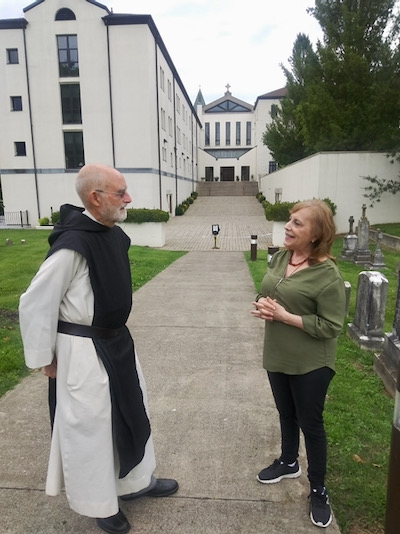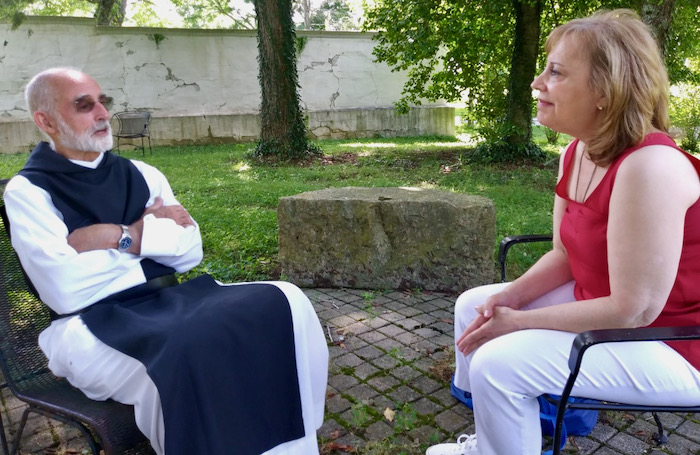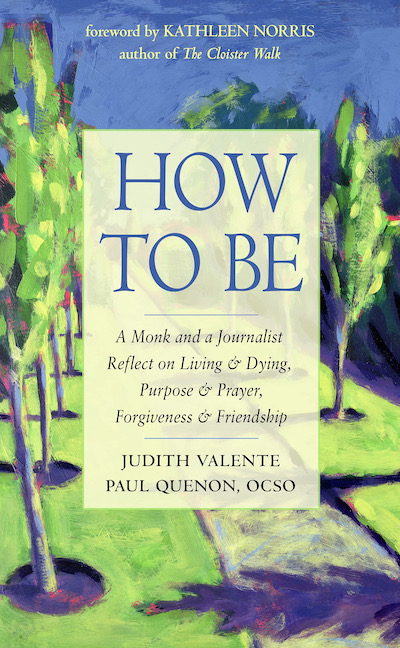First, meet the co-authors of these remarkable letters
JUDITH VALENTE is a long-time friend of ReadTheSpirit magazine and her work has been featured dozens of times in our pages since our founding in 2007—including this column she wrote for us about her earlier, related book How to Live. She is one of the nation’s top journalists writing about religion for media venues that have ranged from major newspapers to the PBS network to public radio.
BROTHER PAUL QUENON is best known as a poet. He entered the Trappist Abbey of Gethsemani, part of the Cistercian order, in Kentucky in 1958 when Thomas Merton was the novice master. Later, Merton served as Brother Paul’s spiritual director and encouraged him to publish his writings. Among Brother Paul’s earlier books is The Art of Pausing, which he co-authored with Judith. You may have seen him in documentaries or media reports over the years.
IN THIS SHORT YouTube CLIP, they talk about their letter writing, which forms the basis of this new book.
Then, Enjoy this Foreword to the book by Kathleen Norris
KATHLEEN NORRIS is famous for her own books exploring spirituality, including The Cloister Walk (1996), Amazing Grace: A Vocabulary of Faith (1998) and Acedia and Me: A Marriage, Monks, and A Writer’s Life (2008). She wrote the following Foreword for this new book.
This book of correspondence is a refreshment, a reminder that although “interconnectivity” has become a buzzword, and technology allows us to contact one another in a dazzling variety of new ways, something vital is missing. Emails travel around the world in seconds, but in gaining efficiency and speed, we risk losing the ability to listen. We long for deeper communication with others, and this book shows us one way to find it.
How to Be introduces us to Judith Valente, a married woman, a journalist and retreat leader with a hectic schedule, and Brother Paul Quenon, a celibate and a contemplative Cistercian monk at the Abbey of Gethsemani. We all benefit from the decision they made to deepen their relationship by means of letters. Brother Paul’s helpful comment about the difference between an email message and correspondence is borne out in etymology. The word “message” is related to “mission” and implies using words to advance an agenda. The word “correspondence,” by comparison, is derived from “engagement,” suggesting something deeper, a pledge to be open and honest with another person. In corresponding with a friend, we have no agenda other than fostering friendship.
That’s intriguing, but the reader might wonder about the value of paying attention to the ramblings of two people, as interesting as they are. Reading their letters could seem as meaningless as hearing another person’s dreams. But the subjects these two touch on are universal. We all deal with illness and death, grief and loss, work, play, and the use of our time, and the musings in these letters can help us determine our own path through the glorious mess called life.
Like Judith, most of us know what it’s like to be so consumed by work that we lose sleep over it. We fret over being so overloaded and distracted that at the end of the day we feel it’s all been wasted time. But few of us hear the wisdom of Brother Paul’s responses to her lament: that a good way to get over the feeling that you’re wasting your time is to waste more of it. He suggests that she intentionally slow down and look around her to see what’s really there. How liberating to embrace his Zen-like wisdom, that the purpose of life is that it doesn’t need a purpose: the purpose of life is life.
It’s good to hear two thoughtful people reflecting on their lived experience. Judith, a self-described “over-achiever,” is often anxious and Paul is more calm, reflecting on the fruits of a monastic life structured so as to foster contemplation. Both are modern people, well aware of the uneasiness that pervades our culture. But Paul reminds us that it’s all right to admit that we don’t always know what to hope for. If we don’t understand what’s happening to and around us, maybe that’s how God wants it. Citing a comment by his mentor Thomas Merton that Jesus will always seek out the most lowly crib, he adds that the holy is often found in places we are most reluctant to look.
 Many of us can identify with Judith’s difficulty in devoting time to pray, let alone praying attentively, and with Brother Paul’s admission that he tends to fall asleep when he’s meditating. Fortunately their views on spirituality and religion are not sectarian, and both reflect on experiences with people of other faiths. Paul offers an indelible image of Buddhist monks playing soccer with children outside Merton’s hermitage; Judith discusses her study of meditation with a Tibetan Lama. As Christians, both ponder their experience of receiving the eucharist at Mass. Judith speaks of the wonder of carrying the body of Christ within her; Paul says it makes him realize that every Christian is a reincarnation of Christ.
Many of us can identify with Judith’s difficulty in devoting time to pray, let alone praying attentively, and with Brother Paul’s admission that he tends to fall asleep when he’s meditating. Fortunately their views on spirituality and religion are not sectarian, and both reflect on experiences with people of other faiths. Paul offers an indelible image of Buddhist monks playing soccer with children outside Merton’s hermitage; Judith discusses her study of meditation with a Tibetan Lama. As Christians, both ponder their experience of receiving the eucharist at Mass. Judith speaks of the wonder of carrying the body of Christ within her; Paul says it makes him realize that every Christian is a reincarnation of Christ.
One thing that connects these two disparate people is poetry, and it’s delightful to see the way they share their own poems as well as the work of others who have inspired them: Emily Dickinson, Walt Whitman and a contemporary, Mary Oliver. Poets do not shy away from difficult subjects, and the reflections on suffering and death in these letters have been especially helpful to me. Judith recalls that a man she’d interviewed for a Wall Street Journal article told her, as he neared death, that “the line between life and death is thinner than you think.” A Benedictine monastery is a thin place by design, as each monk lives with Benedict’s admonition in his Rule for monks, to “keep death daily before your eyes.”
Judith says she’s always struggled with the Christian notion of death as being “born to eternal life, as lovely as that sounds.” And Paul admits that he rarely thinks about heaven, but finds “much of the Resurrection in our love of the world and of the beauty that nature presents. In loving nature, in loving the world, we love something larger than ourselves, and we are made larger by that loving.”
This book is a generous invitation to a conversation, a word with special meaning for Benedictines. One of the vows they make is to conversatio morum, loosely translated as “conversation of life.” The word “conversation” is rooted in a word meaning to turn, to change, to be versatile rather than rigid. And the joy of conversation in that sense enriches these letters. In discussing the effect of the pandemic, for example, Judith says that the enforced isolation made her deeply grateful to see her mail carrier every day, and allowed her to engage in cooking as a meditative practice. Paul reminds us that “love starts at home,” and with people spending more time with their families the pandemic might be seen as a challenge to develop more compassion and empathy.
This book has given me a challenge: I now want to think of someone, a friend living close by or far away, who would be willing to engage in the kind of meandering but deeply meaningful correspondence contained in this book.
.
.
.
.
.


